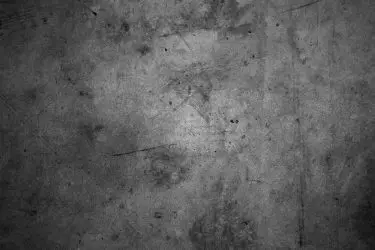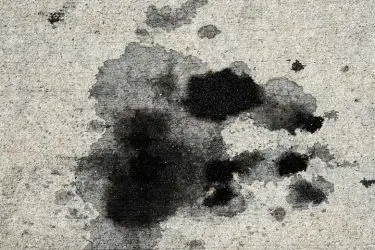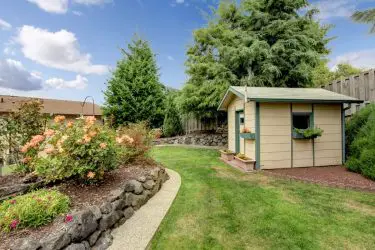Concrete is a go-to for many DIY-ers, home improvement professionals, and construction workers for many reasons. It is one of the most popular materials for home improvement projects because it is easy to use and lasts a long time. However, there are still some drawbacks to using concrete, so you should read up before deciding to use it in your home.
Some advantages of using concrete include its durability, longevity, low cost, and customizability. It is also readily available and easy to DIY. However, concrete is also sensitive to extreme weather conditions, very heavy, needs a solid foundation, and can take almost a month to fully harden.
Let’s talk about all of the pros and cons of using concrete. We will look into the materials that concrete is made of, how to care for it, and all of the reasons why it may or may not be the best choice for you.
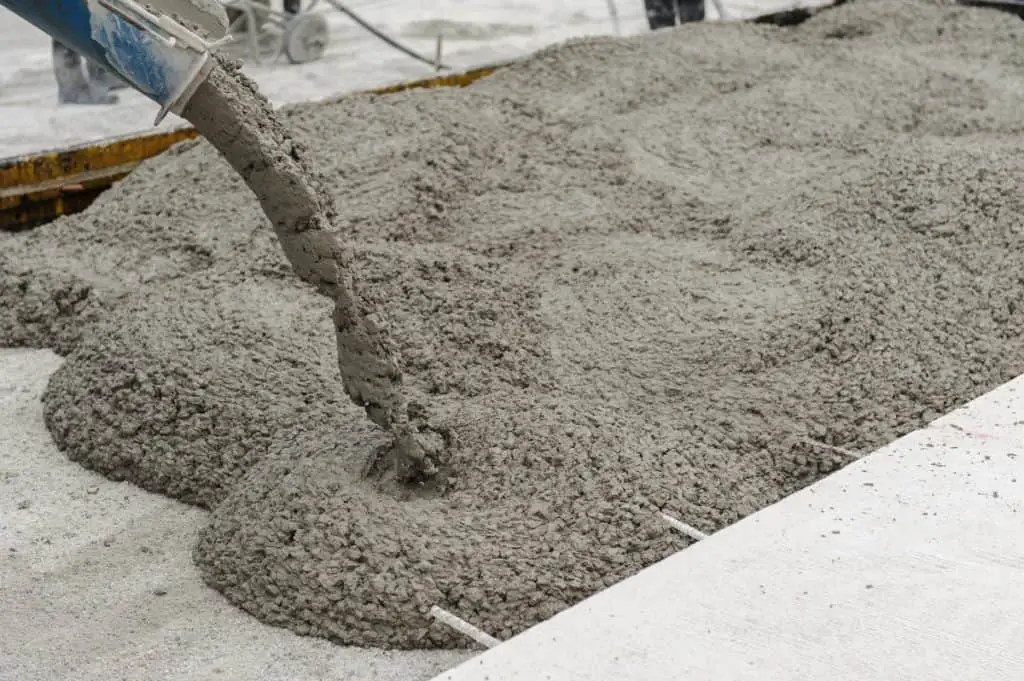
Table of Contents
What Is Concrete Made Out Of?
Concrete usually is made out of coarse stone dust and sand that is bonded together with cement. Concrete can be made from various types of rocks such as limestone, sand, gravel, and other materials combined with a powdered cement base.
When water is added to this powdery mixture, a chemical reaction occurs that permanently binds all of the stone components together, forming a solid, stone-like slab.
Usually, concrete mixtures contain 10% cement, 20% air and water, 30% sand, and 40% gravel. You can alter this mixture to make different concrete types, but this mixing ratio is used to get the most durable product possible.
Advantages of Using Concrete
Concrete is an excellent material for many reasons. It is often readily available, incredibly durable, easy to make at home, and requires little maintenance. Depending on your intended project, it might be the best material for the job.
Easy To Find
You can get concrete almost anywhere. From home improvement stores and superstores to online shops such as Amazon, you will always be able to find concrete at an affordable price, like the Z Counterform Concrete Countertop Mix.
Because you can find it at almost any store that sells home improvement tools, finding the right amount of concrete for your projects is always simple and affordable.
Lasts a Long Time
Concrete is very durable, and it can last anywhere between 30 to 120 years, depending on how much hard wear it gets and its exposure to cold or wet weather. Concrete is also able to resist abrasive chemicals.
Read more: Average Driveway Lifespan: (With 15 real examples)
It does not rust, decay, or weather like most other building materials, which means it will not have to be replaced over time.
It is also pretty easy to repair, and all you need to do to seal up cracks or chips is to use a concrete crack filler, pour more concrete, or use a patching product on the damaged area.
Extremly Durable Material
Concrete is very durable, especially when compared with wood and stone. Because concrete is poured in solid slabs, it does not have any natural fissures or weak spots, leading to cracking.
In addition, concrete actually gets stronger over time, which is a significant benefit when looking to build something large, like a home.
On the Mohs scale, cured concrete usually has a hardness of anywhere between 3 and 7, with ten being the hardest. Most other stones, such as granite and quartzite, also have a hardness of 7.
So, concrete is just as hard but has no natural cracks and flaws as natural stones do. Because it is both strong and completely solid, concrete is more durable than stone.
Structurally Sound
Because concrete is hard and durable, it will not warp as wood and metal do. Even when concrete gets wet or excessively hot, it does not lose its shape, making it far more structurally sound than other building materials.
Being resistant to warping makes it superior for foundations and floors.
Concrete is also a great choice because it will not need to be replaced within your lifetime, making it much more economical than other materials.
Fireproof
Concrete is impossible to set on fire. Because it is fireproof, many people with fireplaces or gas stoves prefer to use it in their homes to prevent any house fires.
Related Article: Here’s What Concrete To Use for a Fireplace
Some people even use it to make fire pits, candleholders, and grills.

With all of the other benefits of using concrete, the fact that it is fireproof is just another bonus. When you use concrete flooring, countertops, decorations, or other structures, you never need to worry about fire damage.
Related article: Are Concrete Bricks Fireproof? The Facts Explained
Deters Pests
Unlike wood, concrete does not harbor pests such as ants, termites, and rodents. Concrete is pest-proof because it is tough to chew through.
Where a wooden house would be exposed to potential infestations, using concrete is a great way to keep insects and other pests out of your home.
Sanitary
Concrete is straightforward to clean, which means that it does not grow fungus and bacteria as often as other building materials like wood and porous stone.
Even though concrete also counts as a porous material, the particles in concrete are dense and tightly packed, leaving little room for moisture to seep in or for bacteria to spread.
When concrete is sealed it’s an even more sanitary and lasting building material.
Concrete also makes it easy to clean, and all it takes to sanitize concrete is a good wipe-down. Since concrete is smooth and sanitary, it is an excellent choice for floors, countertops, tabletops, and so much more.
Low Cost
Especially when compared to wood, stone, and metal, concrete is very inexpensive. The low price point of concrete has made it a popular material for all sorts of projects.
To have a professional pour concrete slabs should only cost $4-$8 per square foot. However, if you want to customize your slab with designs, impressions, tiles, or irregular shapes, it will cost a bit more.
Read more: Concrete Pricing Guide: All the Facts and Figures
If you want to mix and pour your concrete yourself, you can purchase 80 lbs (36.28 kgs) of concrete mix, which will produce six cubic feet (0.16 cubic meters) of dry concrete, starting at only $5 a bag. That is a lot of savings, so it can be very cost-effective to pour it yourself. Plus, when you pour concrete yourself, you can add impressions like leaves and tiles without paying so much extra.
Easy To Transport
Since concrete is most often sold in a dry, powdered form, it is easy to transport. When you buy other building materials such as wood, stone, and metal, it can be challenging to transport the amount you need to your job site.
Often, you will need multiple truckloads of large, bulky materials. However, since concrete comes in bags of dry powder, you can carry enough concrete to construct a floor in one single truckload.
However, if you need a lot of concrete for a large driveway, for instance, you may need to have a concrete mixer truck deliver the ready mixed concrete and pour it for you.
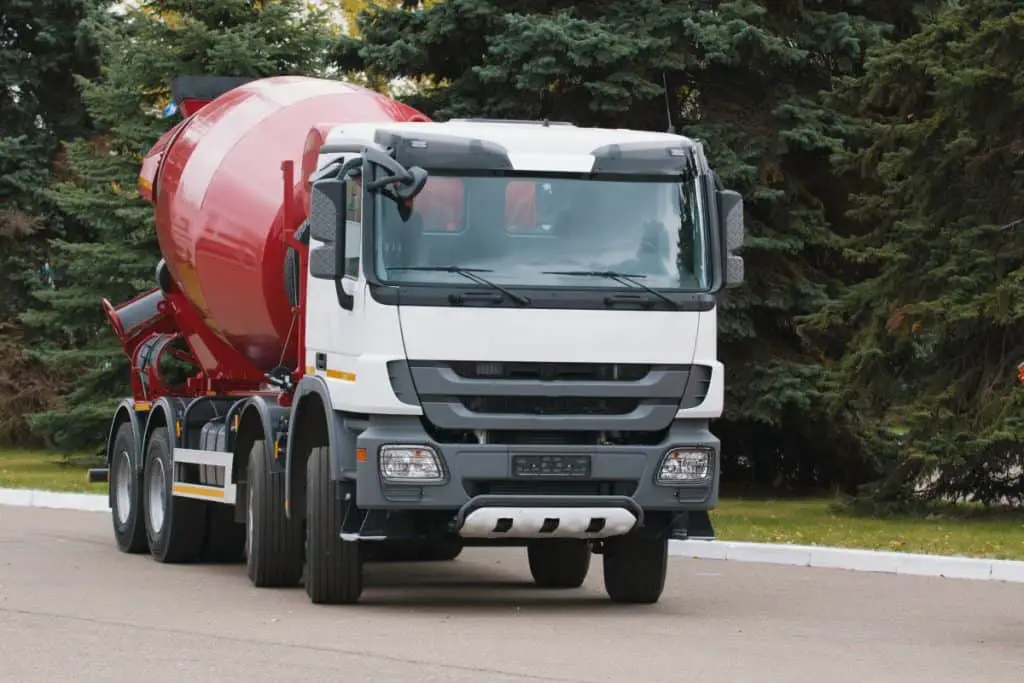
Highly Customizable
Since concrete is made into a paste before you pour it, you can shape and mold it in any way you want. You can make concrete molds for anything, from bowls to counters to paving stones.
People often make leaf, floral, and handprint impressions in their concrete slabs. You can also embed beads, beach glass, tiles, and other decorative items. Truly, there is no limit when it comes to concrete.
You can also add pigments to unmixed concrete to color it. When you add colorants such as mica powder, your concrete will become shinier and less dull-looking. Adding dyes and colored powders to your wet concrete is a great way to personalize your structures or floors.
Since concrete is durable and fireproof, it is also used to make mantles and chimneys. It is also a favorite for building walls, foundations, and floors since it is weatherproof, sturdy, and pest-resistant.
You can use concrete for almost any project you have in mind, so it is always a good idea to have some on hand when you are feeling creative.
Low-Maintenance
If you have ever had wood or natural stone flooring or countertops, you will know that they take a bit of maintenance to keep looking nice.
Wood and stone require sealers and varnishes like wax, mineral oil, and stone sealers. However, concrete rarely requires any sealing since it is relatively non-porous and does not grow mold and bacteria often.
Unsealed concrete is less durable than sealed concrete, though, so if you anticipate that your concrete will get hard wear, you might want to use a concrete sealer like Foundation Armor’s SX5000 WB Waterproof Concrete Sealer.
Usually, these sealers are designed for concrete roads and factory floors where people will drive vehicles over the floor, so the sealer makes the concrete extremely durable.
Soundproof
Since concrete is thick and rigid, it can be an excellent soundproofing material.
Vibrations and sound waves cannot break through a concrete slab’s dense, sturdy surface, making it a fantastic floor and wall material.
Recyclable
Concrete is recyclable, and even if it cracks or chips, you can use it for paving or gravel.
When breaking down old concrete to replace it with something new, such as an old patio, keep the rubble for use as a foundation.
Also, if you break down the old concrete enough, you can remix it and use it all over again.
Retains Heat and Cold
Concrete traps in temperature very well, which can cut down on heating and cooling costs in your home. Not only that but since it can reduce a building’s energy demands by 70%, it can also cut down on carbon emissions.
Concrete can save you money while being beneficial for the planet in some ways. But it’s hard to argue that concrete is great for the environment, most people would say concrete is actually very bad for the environment.
Related Article: Should Concrete Walls be Insulated?
Disadvantages of Using Concrete
Even though concrete has a lot of benefits and advantages, nothing is entirely perfect. Though it is readily available and generally a good material for many different projects, you might find that it cracks under extreme weather conditions and that pouring concrete can take some time and know-how.
Low Tensile Strength
Since concrete is a solid slab that hardly ever bends or warps, it can crack under a lot of tension.
When you place a significant amount of weight on a concrete slab, it cannot bend under the heavy object’s pressure, and sometimes it will crack.
A solid, flat foundation is key to keeping your concrete stable.
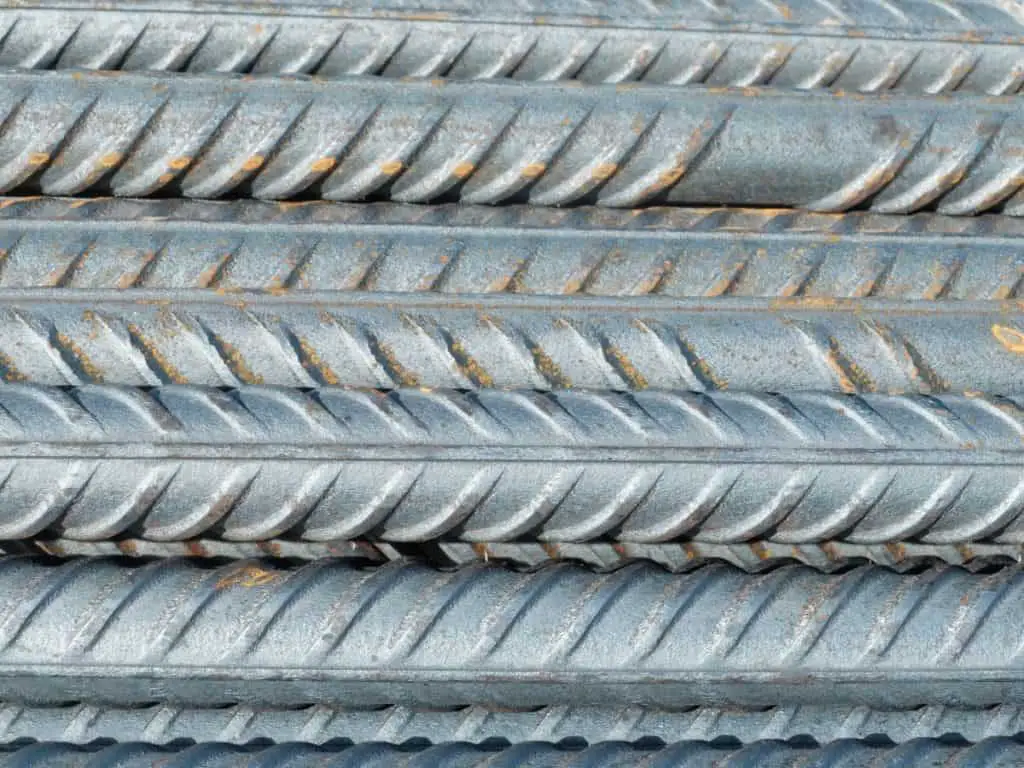
You usually use steel rods to reinforce concrete, which keeps it from cracking under high tension. These bars need to be carefully plotted to ensure that they are not exposed on any side area.
Be aware that if the steel gets wet, it can rust and disintegrate within the concrete, which will cause the slab to crack.
Related article: Rust Stains on Concrete: Causes, prevention, and repair info
Cracks When the Temperature Changes Rapidly
Concrete’s durability can be a drawback when you live in an area where the temperature changes rapidly. Heat causes concrete to expand, and cold temperatures cause it to shrink.
When a concrete structure expands or shrinks too quickly, it can crack or damage the surrounding structure.
On the other hand, when water freezes, it expands. If your concrete is humid or damp, then gets frozen, you might see cracks develop over time.
Cracking is usually not a problem as long as the concrete does not get too wet. But for structures like driveways and foundations, freezing temperatures could quickly damage your concrete slabs.
Usually, this is a problem that occurs in outdoor concrete structures or foundations. If you live in an area where the temperature changes drastically from night to day, concrete might not be the best material for your foundation or pavement.
If you are keeping your concrete in your home, try to regulate the temperature so that it does not change too quickly.
Read more: Why Does Concrete Buckle from Heat? (And how to prevent it)
Takes a While To Cure Fully
If you are working on a tight timeline, it might not be the right material for your project. Concrete dries about 24 hours after you have poured it, but it takes much longer for it to cure.
Concrete cures as the water that it has been mixed in evaporates. As the water evaporates out of the concrete, the limestone, and cement powder bond at a chemical level, forming one solid slab. Before the concrete cures, it is fragile and brittle.
After you have poured your concrete, you should let it sit undisturbed for 48 hours. After the first 48 hours, you can remove the forms or supports.
At this point, your concrete is safe to move or walk on, although it will be brittle and easy to chip, crack, or break. Your concrete may also absorb dust or dirt during this phase, so you should try to keep soil off of it as much as possible.
Within seven days of drying, concrete is safe to drive on. At this point, the water from the concrete mixture has evaporated out, leaving just the stone particles behind.
Your concrete will be much stronger than before, and it will not absorb dust and dirt. You can also clean seven-day-dry concrete with household cleaners, and you can sweep it.
Your concrete will be fully cured after 28 days. It takes four weeks for the limestone and cement base to bond, and over time, they will continue to bond, resulting in an unbelievably strong concrete slab.
Requires a Mold or Form
Unlike wood, metal, and natural stone, concrete requires a mold. When wet, it is poured into a lined mold or a frame (also known as a ‘concrete form’) that gives it its shape.
Because every project is different, you will need to make your concrete form yourself or hire someone else to make it. Depending on the scale of the project, expect the mold to be more expensive than the concrete needed.
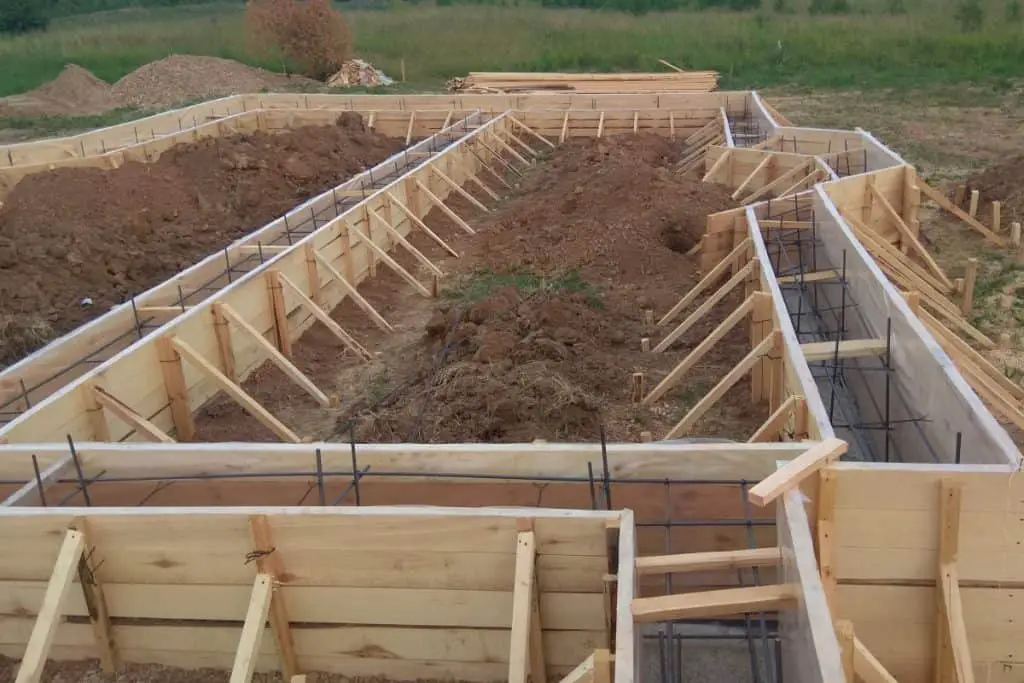
Usually, forms are used for large-scale projects like countertops or floors, and molds are more convenient for smaller objects. These forms and molds are typically made out of plastic, wood, metal, or silicone.
Creeps or Shrinks
Since concrete is usually poured into durable slabs, it can slide or creep if the earth around it warps or erodes.
When rainwater or earthquakes shift the ground around your home, the soil can become displaced, and the concrete will move with the dirt.
Extreme weather conditions can cause cracks in foundations and flooring, and it can also leave large gaps between concrete floors and walls.
Cold weather can also cause concrete slabs to shrink, which could challenge your home’s integrity if you have a concrete foundation or floor.
When the concrete shrinks, any joints between the slabs and walls and other concrete structures will break, forming large cracks.
Also Read: How Much Does Concrete Shrink When It Cures?
To avoid this problem, you should try to keep concrete at a stable temperature. For the foundation, always use multiple layers of sand, gravel, and rebar, set deep into the earth.
You will need the sand and gravel tightly packed under the concrete to allow for drainage. This is especially crucial if you live in areas that see lots of rainfall or flooding.
When installing rebar, ensure it is deep into the earth and does not sit higher than the concrete. When adding concrete to an existing structure, such as steps to a house, be sure to drill, and secure the rebar into the house’s foundations also.
This will help to prevent too much movement and can prevent cracking, creeping, and sliding.
Heavy
Concrete is a heavy, bulky material, which could be an advantage, but it could also make some projects, such as making countertops or benches, very difficult.
Once your concrete has cured completely, it will be even heavier than when you poured it, which makes for a formidable structure.
If you are making a concrete countertop or table, you will need to be careful that the concrete’s weight does not warp or break your house’s floor. For countertops, be sure to reinforce the cabinets underneath to account for the added weight.
Still, if you want a heavy object like an outdoor structure or landscaping structure that will not wash away in extreme weather, concrete will stay put no matter what.
The greatest obstacle, however, is moving the slab once it is dry. You may need to get creative when moving large concrete slabs, and you might even need a forklift or crane.
Absorbs Moisture
When left unsealed, concrete absorbs moisture over time, affecting the integrity of the concrete itself and any wood nearby.
Because most concrete floors and foundations are often covered in wood, you should always use a dehumidifier in areas with both concrete and wood to avoid any dangerous moisture.
Humid concrete is also more likely to soften, which can cause it to erode or make it more brittle over time.
Similarly, when installing hardwood floors, you need to ensure that the sub-floor is dry before adding the flooring. Any moisture left under the hardwood can seep up and cause buckling or cupping.
To avoid this, allow your concrete sub-floor to completely cure and dry before adding your hardwood, and run the heat and air conditioning to allow the house to acclimatize. If in doubt, use a moisture meter to check the moisture levels in the concrete.

You should also seal your concrete, using a special concrete sealer. These products make concrete less brittle, and they keep water from seeping in.
Sealers can also give concrete a sheer, glossy surface, making sealed concrete substantially more attractive than untreated.
Read more: 11 Best Concrete Sealers (and a few mistakes to avoid)
Slowly Erodes
When there is a lot of water running over concrete, it becomes softer and slowly erodes.
Usually, it takes a long time for concrete to deteriorate, but it is more likely to wash away if you use steel reinforcing rods in the foundation.
Since steel is sensitive to water, the more water your concrete structure is exposed to, the quicker the steel bars will corrode and disintegrate within the concrete.
To prevent erosion, you may want to use a waterproof impregnating concrete sealer to keep all of the moisture and humidity out of your slabs.
These sealers can make concrete last a lot longer, and they can prevent chipping, cracking, and erosion.
Sealers are very easy to find, and they are not very expensive. We recommend Foundation Armor’s SX5000 WB Waterproof Concrete Sealer, which is so effective that you can even use it on roads.
Gray Color
We do not have to tell you this one, but concrete is gray. Most concrete structures have a dull, matte gray finish that is not necessarily beautiful or exciting. Depending on your project, that may be a dealbreaker.
However, if you pour your concrete yourself, you can use mica pigments to add some color. Still, the result is usually dull and matte, so if you want a beautiful, marbled effect, concrete might not be the right choice for you.
Or you might look into concrete staining. It opens up a whole new world of customizing your dull grey concrete!
How To Take Care of Concrete
Concrete is a popular building material, despite its downfalls. There are several simple ways to compensate for concrete’s disadvantages, strengthening your concrete and making it last a very long time.
If you want to keep your concrete in excellent condition, you should seal it, repair it as needed, and keep it clean.
Use a Seal and Cure Product
Concrete curing agents like Quikrete Acrylic Concrete Cure and Seal can help your concrete cure faster. Curing agents will also keep moisture and dirt from penetrating the slab’s surface, so it is always a good idea to use them.
After you have poured your concrete, cover the surface with a cure and seal product once the concrete has dried for 24 hours. Then cover the area with a tarp or plastic to keep it dry and dirt-free until it has completely cured.
Repair Cracks As Soon as They Appear
If your concrete cracks, it is imperative that you repair it as quickly as possible. When left untreated, concrete cracks can promptly expand, potentially damaging your entire concrete slab.
If you see any cracking, use a concrete crack repair product like Red Devil’s Concrete Patch. These patching materials will not shrink, and they are often waterproof, so they do a great job at preventing any more damage from occurring.
You may need to remove the old concrete and replace it with new in areas of larger damage. In this case, you will need a bonding agent to ensure the old concrete bonds properly with the new.
Keep Your Concrete Clean
If you allow stains and oils to seep into your concrete surface, they could shorten the lifespan of your slab.
Stains from rust, oil, and salt break down and weaken your concrete, causing it to become more brittle over time.
Dirty, stained concrete is much more likely to crack and chip. If you want your concrete to last as long as possible, clean it at least once a year with a cleaning chemical such as muriatic acid.
Read more: Best Concrete Cleaner for Removing Semi-Permanent Stains
Conclusion
Concrete has many advantages, which is why it is one of the most popular building materials. You can quickly remedy the disadvantages of using concrete by using sealers, cleaning chemicals, and patch kits.
As long as you keep your concrete clean and sealed, you will rarely have to worry about cracking and chipping. Concrete can withstand much hard wear, although it is sensitive to the weather, so you should try to keep it at a constant temperature.

